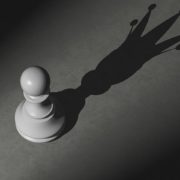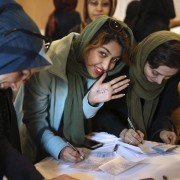What is China and what is Zhongguo? The two words are casually translated into each other from Chinese into English/Western languages, to the point that we don’t see the difference between the two.
Yet, what we now perceive to be “China” coming to be “Zhongguo” is a matter of paramount importance for the place and the role of China in the present world and the future development of the country.
It is a matter of identity and destiny, what the country wants and will want to do, and how the rest of the world, especially the now-dominant Western world, will deal with it. And it is extremely important for the rest of the world to be able to efficiently deal with the country, and avoid costly mistakes from “China” and from the world.
This is perhaps the unspoken subject of Ge Zhaoguang’s philosophical masterpiece An Intellectual History of China, which has been recently published in English, and his What is China?
Professor Ge tries to trace back for the first time the history of the different Weltanschauung, worldviews, in the history of China, which in itself is a completely different vision of the history of the country.
In the 1920’s and ’30’s, under Western influence, China completely revolutionized the way it saw itself. Feng Youlan’s History of Chinese Philosophy, Hu Shih’s The Development of the Logical Method in Ancient China, and Hsiao Kong-chüan’s History of Chinese Political Thought for instance were seminal in “rearranging” Chinese visions of its knowledge according to categories proper to Western thought. In fact, concepts such as “philosophy,” “logic,” and “political thought” didn’t exist in China before the massive influence of Western thought one century ago. Therefore, the work of those Chinese scholars educated in America reorganized how the Chinese saw their knowledge and contributed some important ideas that helped to West to see itself differently.
For example, Feng traced the origin of the different ways of thinking in the different geopolitical contexts. Ancient Greeks were traders and sea-farers, their space was the Mediterranean Sea; Ancient Chinese were farmers and their space conversely was the Yellow River plains. These two different environments gave birth to distinct traditions.
Yet something more important was afoot, suggests professor Ge, something that had happened before in the history of China: how the Chinese and China saw themselves and their “country” changed after a historical crisis that reshaped their vision of the world. The crises are political-cultural, but it is the cultural reexamination of itself that historically brought about the different new “Chinas” that we find in its 3,000 years of history.
China-Zongguo-Tianxia
“China-Zhongguo” is in itself a new concept. As Professor Ge points out, the idea of equating what is roughly the country of China with Zhongguo came from the Jesuit Matteo Ricci around the year 1600. Surely, the word Zhong guo existed before. It is first found in the ancient literature, meaning the states (Lu, Song…) of the central plain as the original cradle of culture and as opposed to the then new larger states (Qin, Chu…) emerging around the Yellow River plain.
We find the word Zhongguo again during the early centuries of the Christian era, pointing sometimes at India as the country that is the origin of the new culture and religion of Buddhism that was sweeping through China and India then. The term comes up once more during the Southern Song period as a definition of the Song rump state in the south, whereas the Khitan kingdom that had defeated the Song, occupied the north.
In all other times, China was not Zhongguo; it was simply Tianxia, all which is under heaven. The Song’s Zhongguo was a recognition of the breakdown of the unity of the Tianxia and an admission that the Khitan were part of the “Chinese world” of Tianxia.
It was not like ancient Chinese didn’t know that the rest of the world existed and that there were other countries outside of the rule of the son of Heaven, the emperor. It was that they thought that the rest of the world didn’t matter; it was irrelevant. The idea of foreign irrelevance was reinforced by the physical barriers isolating China from the rest of the world: the deserts in the northwest, the high mountains and the impenetrable jungles in the south, and the ocean on the east.
Moreover, all of China’s neighbors were deemed culturally inferior to the Chinese; therefore there was objectively not too much interest in dealing with foreign cultures. It was also extremely difficult to try to expand in any of these directions. The northern steppes were sparsely populated, and it was difficult to sustain a stable presence there, an agricultural society with the organization of China there. There was a similar situation in the south and east.
In this isolation, China simply saw itself as the only relevant entity. The Chinese were furthermore not identified along the ethnic lines that were used in Western society at the time, but according to culture. They were Huaren, the flowery people, well versed in traditional culture, whatever their origin might be.
Chinese changing visions of themselves
Still Ricci’s contribution, which changed the way the Chinese saw themselves in the world and how they saw the world, came about as the development of a “Chinese” tradition, says Ge. The Chinese changed visions of the world many times in the past. The earliest that we can find was in Shang-Zhou times; then with the breakdown of the Zhou “empire” came the golden age of Chinese thinking with its traditional philosophers. From then on, Ge Zhaoguang follows the evolution and dramatic changes of worldview, reflecting the dramatic changes of the empire.
Behind the continuity of culture and tradition, China dramatically changed the way it perceived itself. In the second half of the 1st millennium BC for instance the “Chinese” warring states saw themselves as part of a community (koiné) but certainly those states were also extremely jealous of their independence. The vision altered with the unification of the Qin and Han, which in about 400 years began to shape a perhaps unprecedented common sense of belonging to one unity.
New Buddhist China
Yet Buddhism was maybe an even more dramatic shift for China-Tianxia, which it took almost a thousand years to digest. It came after the fall of the Han Empire and at the heel of centuries of wars that reduced the Chinese population by possibly 2/3. China-Tianxia had to come around to a new way of reasoning that could let it live with all those slaughters, leave them behind and find a new path for the new imperial unity of the 7th century under the Tang dynasty.
It was a long trial where Buddhism, at the beginning a completely foreign way of thinking, integrated itself with the pre-existing culture through a complex reasoning, that forged Chinese ways of seeing themselves to the point that even now modern Chinese can’t say they are not Buddhists.
Actually, a new book, with nothing to do with China, helps us to understand better what Ge Zhaoguang refers to this trial of reason which shaped the country. In The Enigma of Reason (2017), Hugo Mercier and Dan Sperber argue that the main purpose of reason and reasoning is social, to build a consensus in a community by arguments. They say, “reason is more efficient in evaluating good arguments than in producing them: when the arguments are there, the scientific community is able to elevate the status of a new theory from fringe to textbook material in a few years.”
In a very traditionally tight-knit society, like traditional China, “creative reason” producing new arguments must have proven even more difficult. This is for two reasons. To create “new reason” and use it to convince others, the reasoning has to get out of the old track and get back to the original reasoning by trying to bend it to new directions.
The new thinking of the Indian monks spreading their religion east managed to conquer the hearts and minds of the common people first absorbing the pre-existing Taoist popular religion and then finding ways to co-exist with the Confucian state rituals that became dominant again with the reunification of the Empire.
In some ways the Jesuits coming to China some 15 centuries after the Buddhist were trying to do the same, and possibly Ricci found that a crisis was afoot in China, which kept aloof and distant from the massive geo-political revolution started from the discovery of the American continent.
This is what Ricci did, according to Ge Zhaoguang, when he first converted to being “Chinese” and then, when he was recognized as a cultured flowery person, thus Huaren (Chinese, as we would say now), he explained that he belonged to a different but equally refined civilization, the European one.
This approach which in turn triggered the curiosity of the Chinese court to try to understand what the world was according to the Chinese/Huaren/non-Chinese. The interests of the Ming might have also been piqued by their inclusion in the global flow of silver from Mexico and the agricultural revolution that brought potatoes, chili and peanuts to Beijing. As many historians have argued, Mexican silver actually rescued the Ming dynasty from a severe economic crisis in the 16th century and then its mismanagement led to its downfall a few decades later.
At the time, when the Ming court was considering what to do with the trade of Portuguese silver, Ricci, with his new worldview, was actually contributing to explaining where the new trade was coming from and what it meant. In hindsight, if the Emperor had really understood the Ricci’s message, the fact that the Ming had to actively participate and manage the new world order started with the American trade, perhaps the dynasty could have been saved.
Yet for the Beijing imperial court this was no immediate threat to face. The famines and rebellions spreading in the country at the beginning of the 17th century seemed more linked with the past traditions of popular uprisings.
The real threat, as many times in past millennia in China, came from the north, with the Manchu takeover of China/Tianxia, which took place just some thirty years after Ricci had passed away in the Chinese capital.
The reason of a new sense of China
The goal of producing a new sense of reason, one gathers from the argument of Hugo Mercier and Dan Sperber, is to strengthen the group, like food for the mind, that makes the group stronger, especially in moments of crisis when the group is losing cohesion.
But this is not only the work of intellectual reason but also the capacity to move others emotionally, which is actually how reason might be better understood in China. Emotion and reason seem to be two sides of the same coin.
Then in comparison with other crisis, the political/cultural collapse in the 19th century with the western powers forcing their way into China was a shock much harder to digest than the slaughtering wars starting with the fall of the Han dynasty in the 3rd century AD and the inflow of Buddhism and other religions from South and Central Asia.
The defeat at hands of the Japanese, looked down upon for over a thousand of years, in 1895 and subsequently the uncontroversial defeat at the hands of Western powers in the 1900 Boxer uprising sent China into a state of shock from which perhaps it is still recovering.
Professor Ge ends his book by noting that «in 1895, Yan Fu … published his “On the Origin of Strength” (Yuanqiang); this title also expressed the road chosen by those intellectuals: only “wealth and power” could successfully deal with the enormous “world change”, only facing up to this great change, unprecedented in two thousand years of Chinese history, could guarantee the racial heritage of the nation that would not be cut off. In order to achieve this priority goal, China had to accept the Western road to modernization».
This is an issue still tormenting China. And yet perhaps this very book provides a way forward. Ge Zhaoguang has fully absorbed the modern Western ways of looking at things – perhaps Foucault is one of his strongest inspiration – but he then fuses it with a typical Chinese traditional vision, looking at things in a wide mirror. Nothing similar exists for Western culture – there is not a history of Western Weltanschauung explaining the crisis of the West. And still the West should deeply reconsider how it came to be what it is now. It is not like the West didn’t change from the Greek-Roman times until now.
The cultural/political challenges the west faces now are also unprecedented and should help to reconsider what really made the West what it is. For instance, one element that is sorely overlooked now, was the Chinese influence, through the Jesuits’ translations, in creating new ideas and concepts that eventually inspired both Adam Smith’s ideas of modern market in Great Britain and the movement of the Enlightenment in France.
Then unlike the work of Feng Youlan or Hu Shih almost a century ago, Ge’s work could be a true inspiration to reconsider the intellectual history of the west in a new fashion. In this way Ge could be really one the first contributions that although deeply steeped in Chinese culture manages to move also out of it. In other words, perhaps also for China accepting the reality of the changes and actively and positively adapting to them, helps the world acknowledge and receive China.
Recensione originale, quando il volume uscì in Cinese per la prima volta.






Dear Francesco,
Wow, that Settimana article was a tour de force. Thanks a million. Am going to buy Ge’s book.
Am using the opportunity to send you my best wishes for 2019 and to thank you for sharing your vast knowledge about China and your insights with readers and friends like me.
Pieter